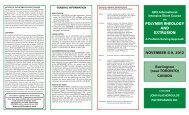The Role of Rheology in Polymer Extrusion - Polydynamics, Inc.
The Role of Rheology in Polymer Extrusion - Polydynamics, Inc.
The Role of Rheology in Polymer Extrusion - Polydynamics, Inc.
Create successful ePaper yourself
Turn your PDF publications into a flip-book with our unique Google optimized e-Paper software.
where m is the consistency and n the power-law exponent. For n = 1, the Newtonian model<br />
(constant viscosity) is obta<strong>in</strong>ed. <strong>The</strong> smaller the value <strong>of</strong> n, the more shear-th<strong>in</strong>n<strong>in</strong>g the polymer.<br />
<strong>The</strong> usual range <strong>of</strong> power-law exponent values is between 0.8 (for PC) and 0.2 (for rubber<br />
compounds). For various grades <strong>of</strong> PE, the range is 0.3 < n < 0.6. <strong>The</strong> consistency has values <strong>in</strong><br />
the usual range <strong>of</strong> 1000 Pas n (some PET res<strong>in</strong>s) to 100,000 Pas n for highly viscous rigid PVC.<br />
This power-law model gives a good fit <strong>of</strong> viscosity data at high shear rates but not at low shear<br />
rates (because as goes to zero, the viscosity goes to <strong>in</strong>f<strong>in</strong>ity).<br />
An approximate calculation <strong>of</strong> both m and n can be carried out by us<strong>in</strong>g two values <strong>of</strong> the<br />
melt <strong>in</strong>dex (MI and HLMI). MI refers to standard weight <strong>of</strong> 2.16 kg and HLMI to “High Load”<br />
melt <strong>in</strong>dex (frequently 10 kg or 21.6 kg). By manipulat<strong>in</strong>g the appropriate equations for pressure<br />
drop, shear stress and flow rate, we have [1]:<br />
log( HL) log( LL )<br />
Power law exponent n <br />
log( HLMI ) log( MI )<br />
8982 (<br />
LL )<br />
Consistency m <br />
n<br />
1838<br />
<br />
MI <br />
<br />
(1.9)<br />
where LL is the standard load (usually 2.16 kg) and HL the high load (usually 10 kg or 21.6 kg).<br />
range:<br />
Two other models are frequently used for better fitt<strong>in</strong>g <strong>of</strong> data over the entire shear rate<br />
Carreau-Yasuda<br />
<br />
<br />
n-1<br />
a<br />
= 1 + ( ) a<br />
(1.10)<br />
o<br />
where o is the viscosity at zero shear and , a, and n are fitted parameters.<br />
Cross model<br />
<br />
o<br />
1 + ( )<br />
=<br />
1-n<br />
(1.11)<br />
where o is the zero shear viscosity and and n are fitted parameters.<br />
With rotational viscometers (cone-and-plate or parallel plate), the shear stress is<br />
determ<strong>in</strong>ed from the applied torque and the shear rate from the rotational speed and the gap<br />
where the fluid is sheared.<br />
Capillary viscometers are usually used for the shear rate range from about 2 s –1 to<br />
perhaps 3000 s –1 . Rotational viscometers are usually used for the range 10 –2 to about 5 s –1 . At<br />
higher rotational speeds, secondary flows and <strong>in</strong>stabilities may occur which <strong>in</strong>validate the simple<br />
6




